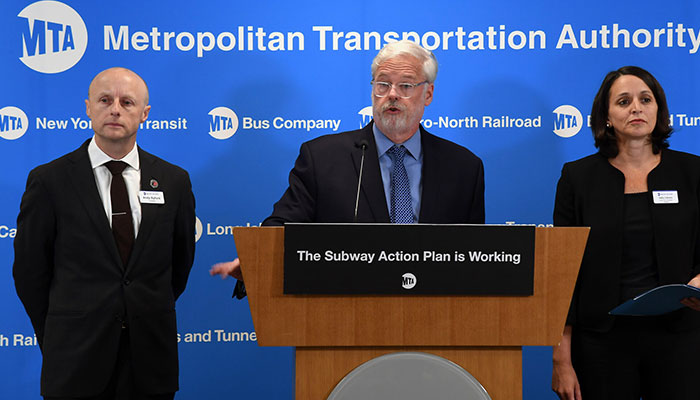Photo Courtesy of Marc Hermann/MTA New York City Transit
“This transformation will allow us to finally give our customers the system they deserve, and prepares us to execute on what is likely to be the biggest capital plan in MTA history,” said MTA Chairman and CEO Patrick Foye.
By Michael V. Cusenza
The Metropolitan Transportation Authority on Friday released a preliminary report of its transformation plan as part of widespread reforms passed in the State Budget in April. The recommendations for this historic reorganization were made following an extensive evaluation process conducted by the consulting firm AlixPartners.
According to the MTA, the transformation plan contains the following key recommendations:
• In the new organization, the agencies should focus exclusively on service delivery, safety, day-to-day operations and maintenance, rather than general support functions. The agencies will have reporting lines to a Chief Operating Officer. All other services will be merged and coordinated centrally with a goal of driving a higher level of services at lower costs. This would result in consolidation of more than 40 functional groups within the existing MTA Agencies to six departments in the new MTA organization. Furthermore, the transformation plan calls for changes to the fundamental ways the MTA does business in order to achieve more effective and efficient performance.
• To address slow, costly, and bureaucratic processes and to create accountability, all Capital-related functions across the MTA should be merged into a central group. This new capital group will be accountable for planning, development, and delivery of the Capital Program. This group would identify optimal project delivery (groupings, timing, delivery), increase competition in a historically constrained supplier market, and complete important capital projects that improve service and customer experience quicker.
• To address inconsistent engineering methods across agencies and eliminate the duplication of processes and standards and ensure quality and sustainability of infrastructure, a new central Engineering group reporting to a Chief Engineering Officer will establish clear engineering and maintenance standards to be executed consistently across all agencies. This will provide consistent standards and specifications and eliminate unnecessary complexity and duplication.
• To address many existing differing communication types (i.e., service updates, timetables, customer feedback, etc.) from several different agencies, MTA should centralize communications to clearly and consistently manage the message, medium and content.
• To eliminate silos and enable multimodal network design optimization, the MTA should centralize operating standards and service design. Currently each MTA agency has its own internal operations standards and service design capabilities, which would be better managed under one integrated function serving all agencies.
• The MTA should create a centralized human resources department focused on attracting, developing, and retaining the talent required to improve MTA performance and service delivery. This new entity will be tasked with clearly articulating a new talent strategy. This will help to resolve issues of duplication and improve analytics, data consistency, and data integrity.
According to the MTA, to drive the transformation, the agency will require a selection of new leadership roles and capabilities:
• A Chief Operating Officer should lead the team of agency leaders including subway, commuter rail, bus, and bridge/tunnel transportation systems to deliver safe, reliable, and cost-effective transportation services. The COO will shape operations with a regional, multimodal view of service design and delivery.
• A Chief Transformation Officer is responsible for leading the execution of ongoing and new initiatives across the $18 billion enterprise. These efforts will include reorganization, development of strong center-led business functions, streamlining business processes, quality assurance and establishing internal controls. According to the MTA, the CTO will play a crucial role in quality assurance and should focus on building and embedding cross-functional capabilities that ensure intended results from vendors and suppliers, including on-time performance and accountability. Waste, fraud, abuse and possible legal violations remain the jurisdiction of the MTA Inspector General. However, the two offices could work collaboratively. This Chief Transformation Officer will report directly to the MTA Board and work closely with the MTA Chief Executive Officer and COO.
• While MTA officials have indicated that they believe the agency has made progress in increasing accessibility to subways, buses, Long Island Rail Road and Metro-North in recent years, much more remains to be done to make the transit system accessible to all customers. To accelerate the creation of a fully accessible transit system, AlixPartners recommended that the MTA should hire the first-ever network-wide MTA Accessibility Officer reporting to the Chief Executive Officer.
“Make no mistake about it, this transformation will allow us to finally give our customers the system they deserve, and prepares us to execute on what is likely to be the biggest capital plan in MTA history,” said MTA Chairman and CEO Patrick Foye.
The release of the AlixPartners analysis arrived a day after the MTA touted the “enormous success of the Subway Action Plan.” On Thursday, the agency noted that subway on-time performance was 81.5 percent, marking the first time it had crossed the 80-percent threshold in six years.

